Ovenbird Transparent Watercolor and Time-lapse Video
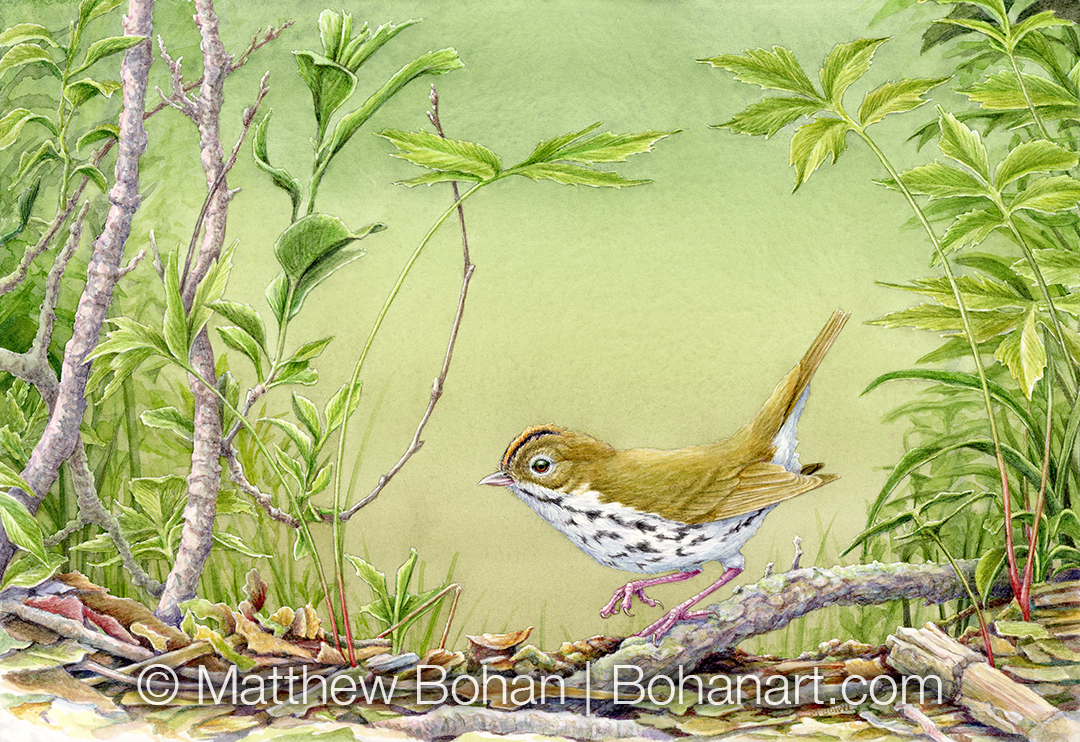
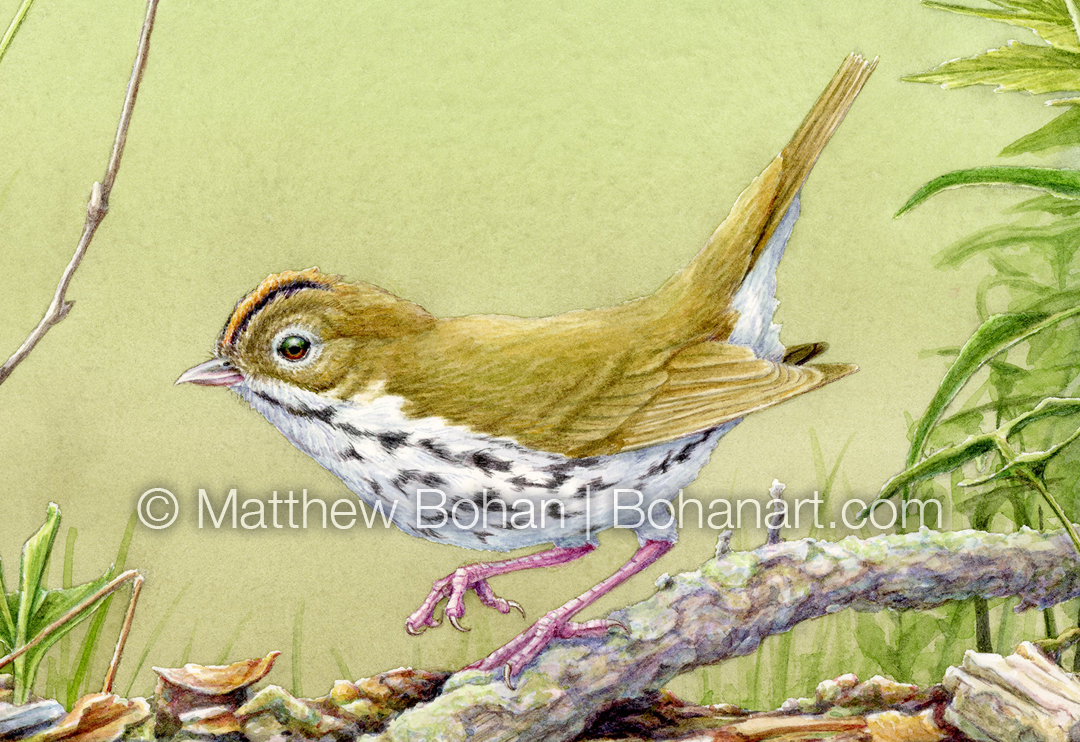
Although I’ve painted hundreds of birds over the years, this is my first Ovenbird! They are undeniably classy. At a quick glance one might look a little more like a thrush than a warbler. That is probably due to them being on the bigger side for a warbler plus having a streaky breast and somewhat brownish tones. It is one of the birds I hear much more often than I see. Their “Teacher-Teacher-Teacher” call lets me know to start searching in case I’ll be lucky enough to get a good look.
Ovenbirds like spending a lot of time in the leaf litter hunting for insects. Unlike most warblers, they nest on the ground, which unfortunately leaves them more at risk from predators. When I’ve visited the Michigan State Bird Banding Station to get photos up close, they seem to have gigantic eyes. I assume that’s to collect more light in the underbrush they like foraging in. Whatever the adaptive reason, they sure look endearing! I love their streaks, olive back, orange mini-stripe and those awesome pink feet. It was an absolute blast to paint this little guy.
Let me know if you’re interested in buying the original watercolor of this or another painting. Prints and licensing are also available for some of my work.
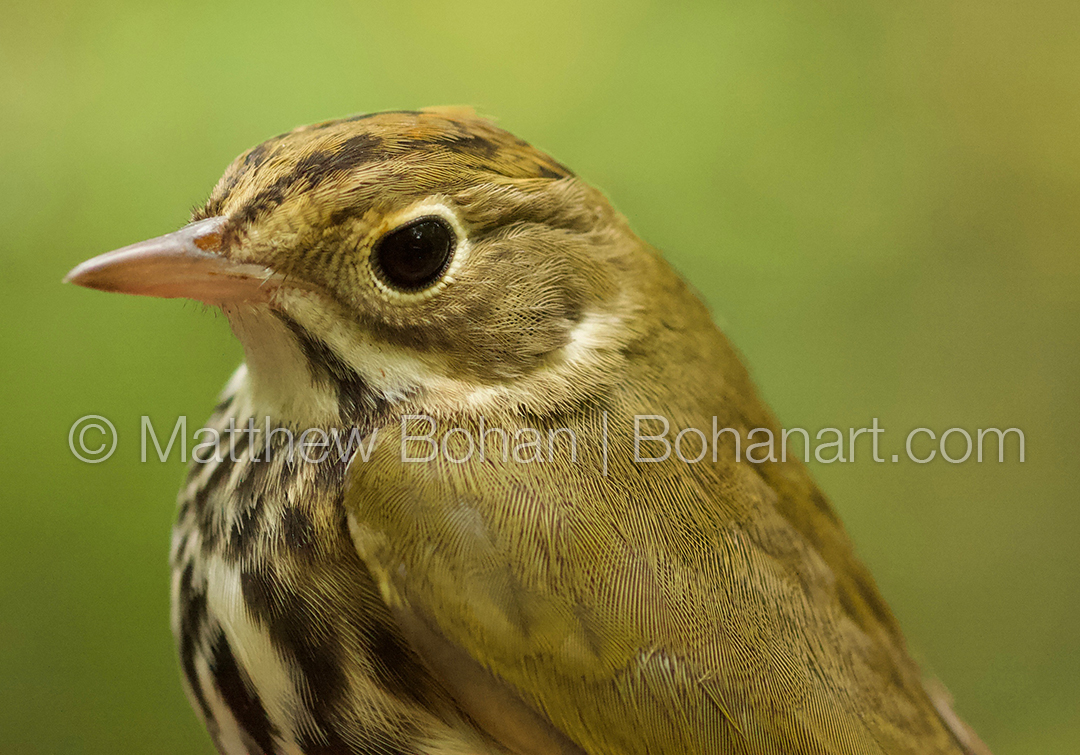
Yellow-throated Warbler on Palm Transparent Watercolor and Time-lapse Video
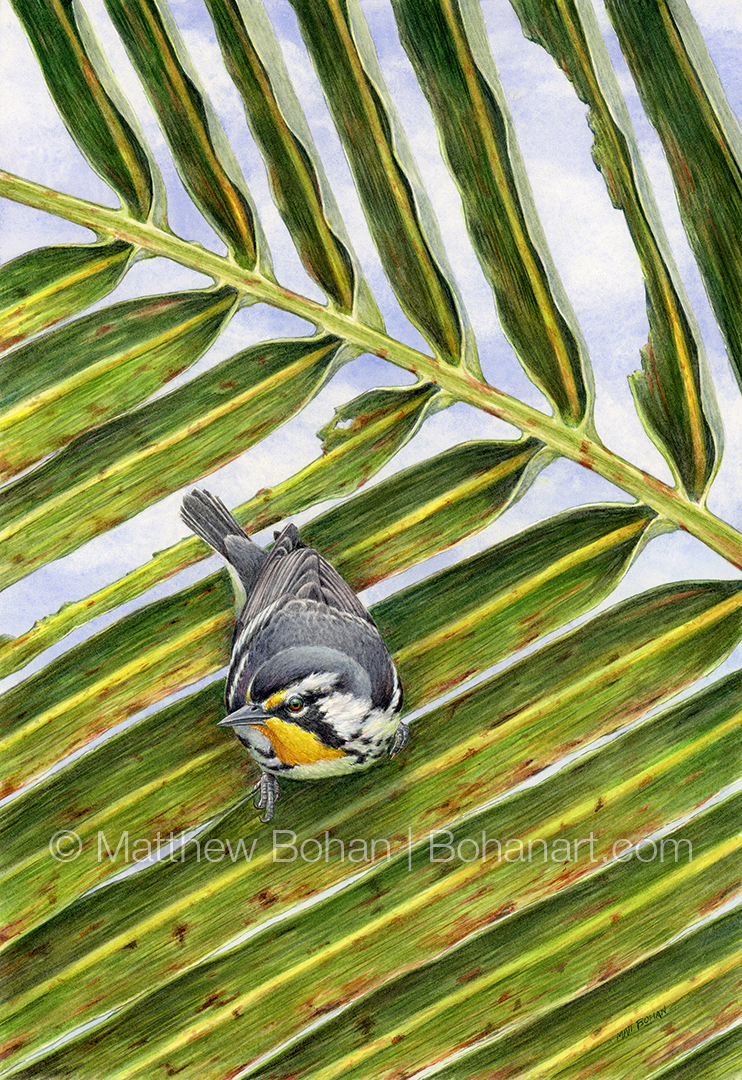

Well, I had enough fun painting the last Yellow-throated Warbler on a Palm that I decided to do another one from the same set of photos from our trip to the Florida. For a long time I tried to only paint birds that I’d never painted before, seeking to add depth to my portfolio. The more I thought about it, however, the more I realized that most birds are worthy of many paintings, so why not just paint what is captivating now if I already have decent references?
I love painting palm trees. In addition to serving as a great design element with all sorts of repeating forms and interesting shadows, they also provide an awesome way to divide a page. OK, I also think some of the novelty is that we just never see them in Michigan, so they are exotic. Nothing growing this state remotely looks like a palm. Maybe the folks down south like painting snow for the same reason?
Below are some favorite older paintings from my portfolio that also feature palms. Let me know if you’re interested in buying the original watercolor or a print of one of my paintings. Some of my work is also available for licensing.
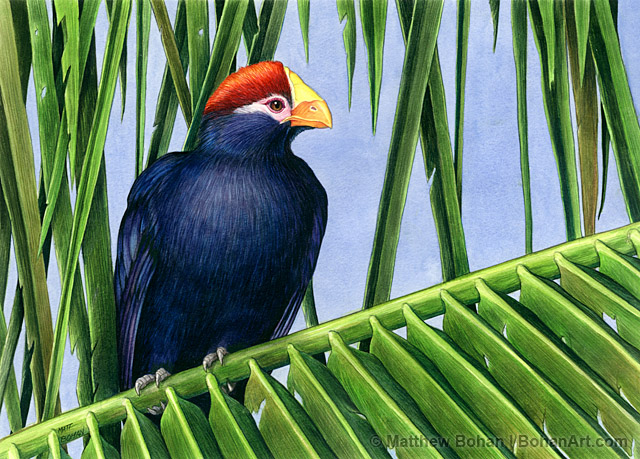
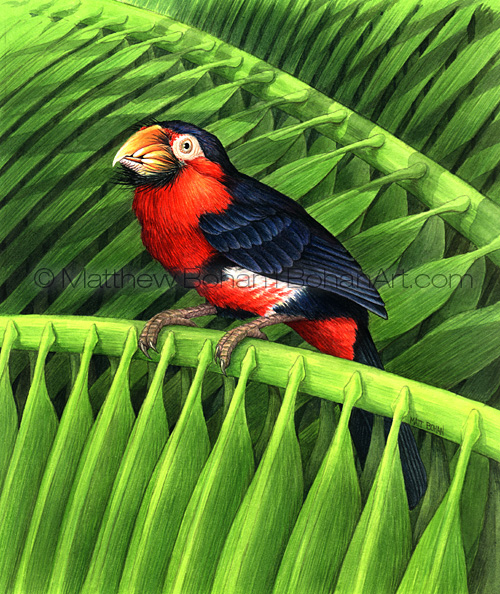
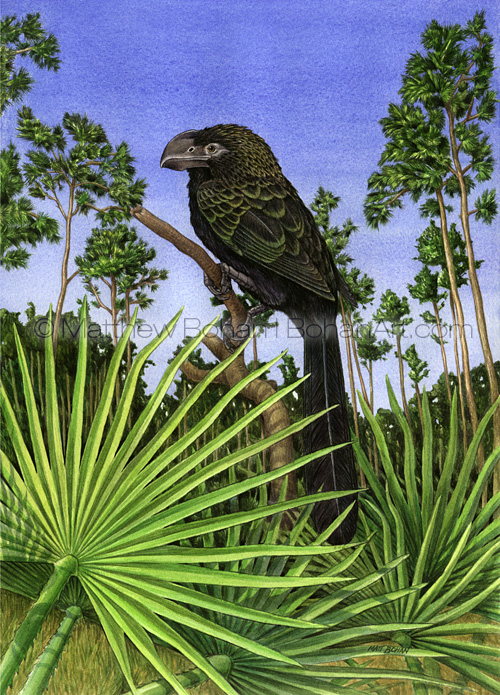
Common Flameback Woodpecker Transparent Watercolor and Time-lapse Video
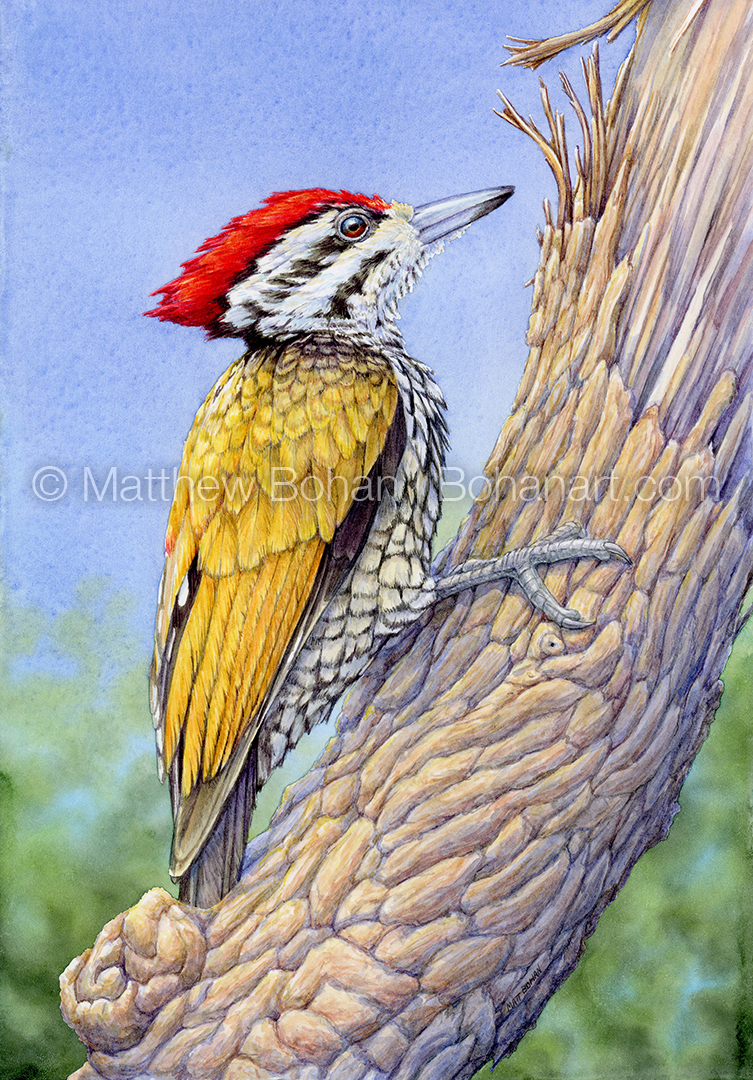

This gorgeous woodpecker, the Common Flameback (Dinopium javanense), is from Southeast Asia and Western India. It is also sometimes called the Common Goldenback Woodpecker. Both common names seem appropriate. I got photo references for this bird from the Toledo Zoo. I tend to paint mostly species I have seen in the wild, but when you get photos of something as beautiful as this, you have to break out the paints. I think my favorite part of this project was playing with the purple-blue shadows and the warm highlights.
Let me know if you’re interested in buying the original watercolor or a print of this painting. Some of my work is also available for licensing.
Yellow-throated Vireo on Red-twig Dogwood Watercolor Painting and Time-lapse Video
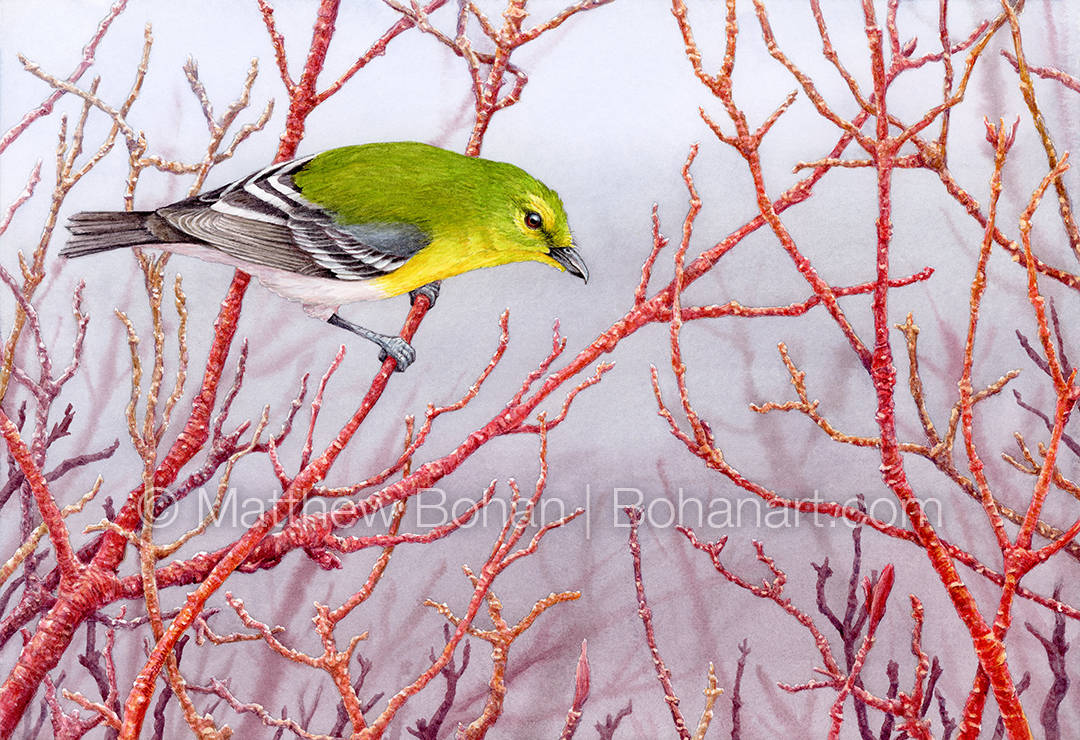
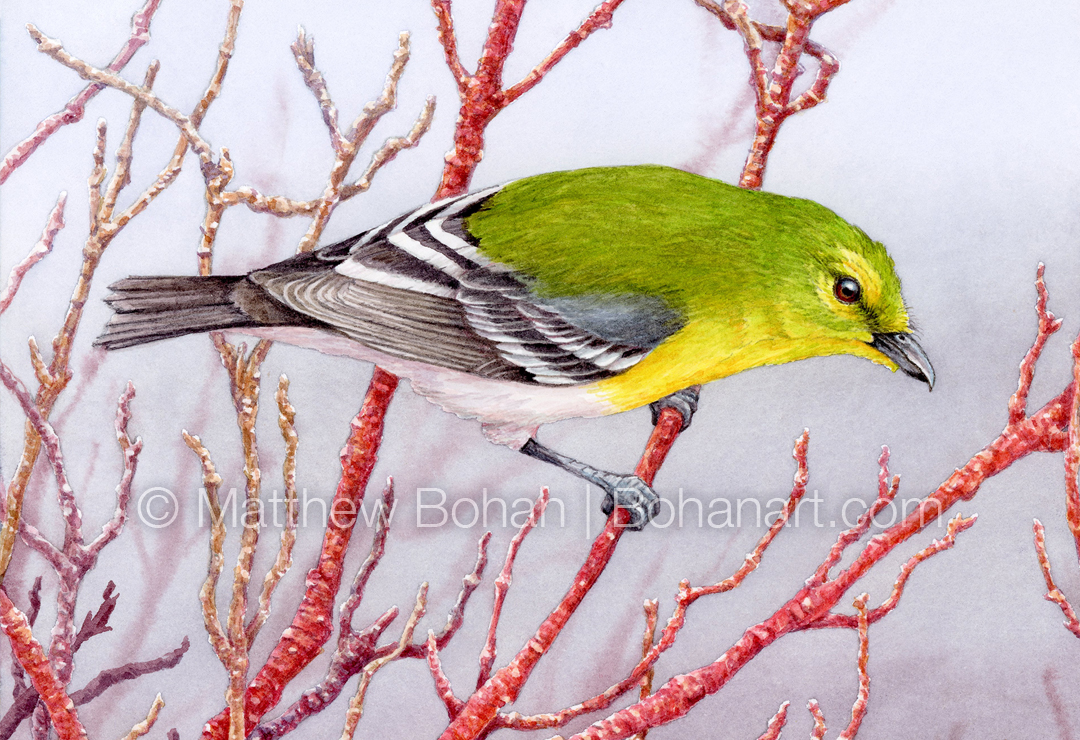
After recently completing a Blue-headed Vireo painting, I thought it would be fun to do a Yellow-throated Vireo. This is a bird I hear ten times more than I see. Three seasons of the year, I get to spend a ton of time mountain biking at Burchfield Park and Riverbend Nature Area. Yellow-throateds breed there, and though I don’t see them that often, I hear their “3up-3year” call as I ride my 20 miles on trails along the Grand River. It is amazing how many calls you can discern while zooming along.
Yellow-throated Vireos are adorable birds, and their yellow eye ring alone makes them pretty irresistible. I also love the way their color transitions from yellow to greens and olive. I’ve gotten a lot of great Yellow-throated macro photos at a local bird banding station. That made it a lot easier to work on the detailed areas of this painting.
At this point I’ve finally painted four types of vireos. It will probably be a while before I get to add any new species. I’ve run out of the common Michigan options. I’d love to add a White-eyed Vireo at some point. We get those occasionally in northern Ohio during spring migration, and they are in range on our trips to Tennessee to visit family. Fingers crossed!
Let me know if you’re interested in buying the original watercolor or a print of this painting. Some of my work is also available for licensing.
Blue-headed Vireo Transparent Watercolor and Time-lapse Video
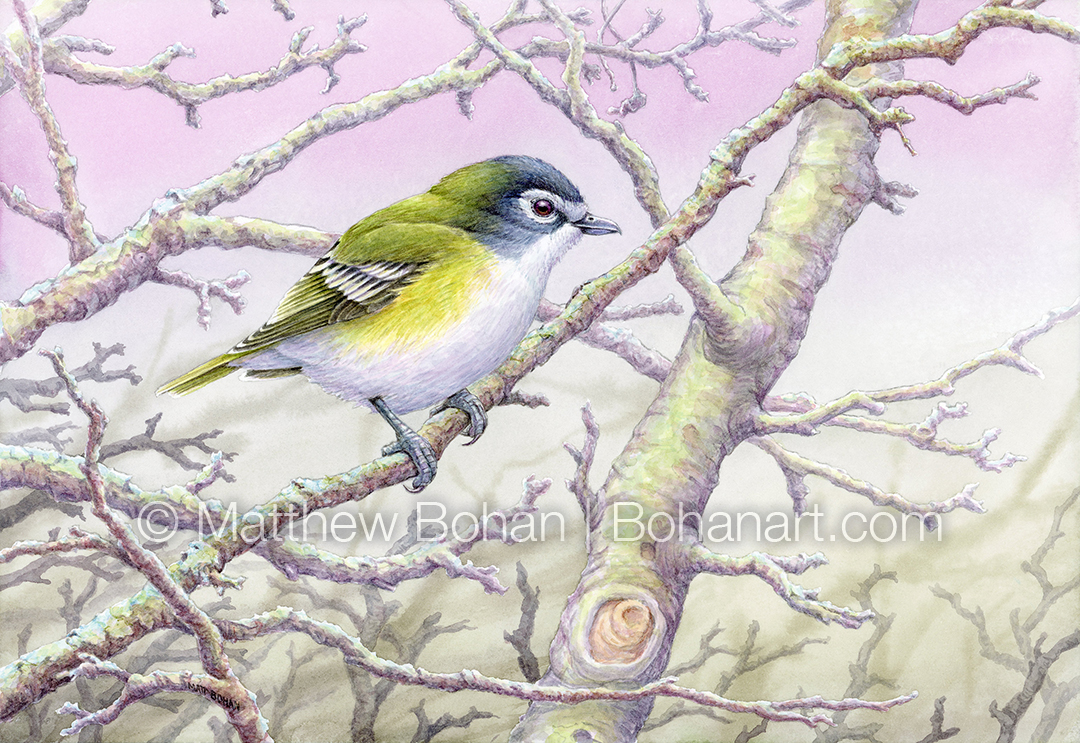
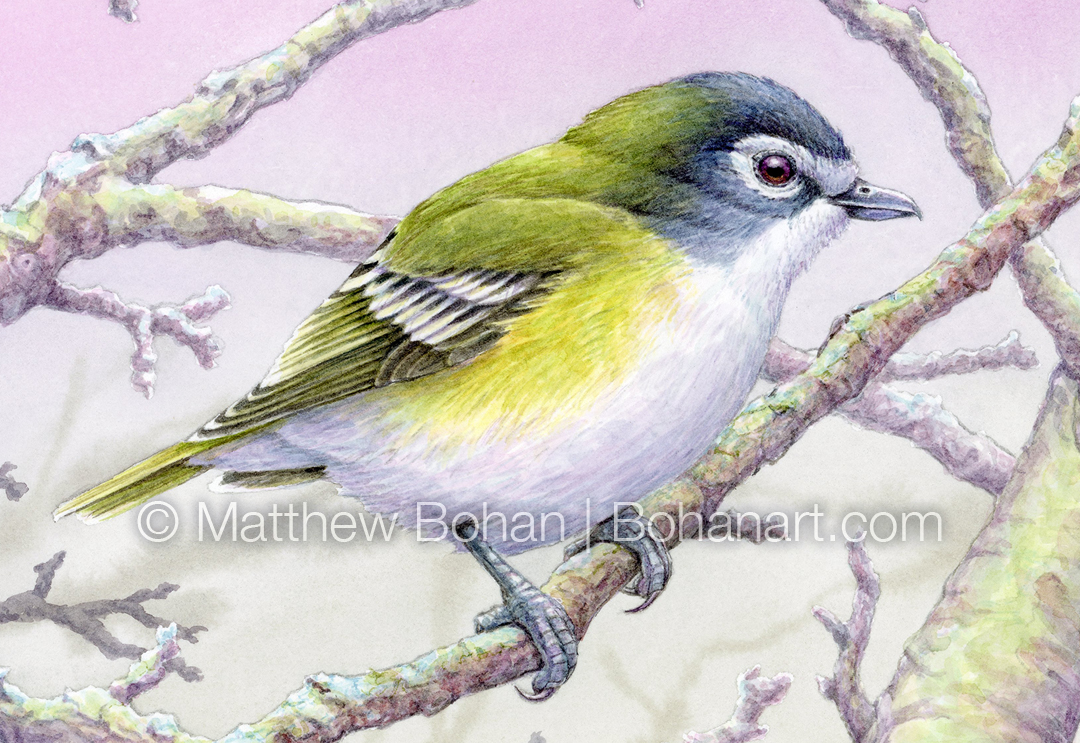

Blue-headed Vireos are one of my all-time favorite birds. They seem like little teddy bears. They are too cute for words, and that little white eye ring is the icing on the cake.
I tend not to see them other than during migration, and then they are a real treat. One of my favorite birding experiences was a fall day in northern Ohio when there was a big push of Blue-headed Vireos, and they seemed to be everywhere at the Maumee Bay Boardwalk Trail.
I’ve seldom had cooperative Blue-headed Vireos to photograph. We did have one late bird visiting our backyard last fall, and I snapped a few photos. The shots weren’t great, with bad definition and borderline focus through the window. Additionally, there was a branch blocking portions of the bird in every photo, but I had enough shots combined for use as a decent reference.
I grew up knowing this bird as the Solitary Video. Years after the name change, I still frequently call them that.
Because my photo reference was pretty lame, I reinvented the lighting to make it more interesting. In a lot of recent work, I’ve found myself ignoring my reference and being less literal with color. While it might be argued that these pieces are less accurate and/or less literal, I think they have ended up being better paintings and have more interesting color and sense of light. I’ve also been doing more wet-on-wet washing, which leaves a little less saturation and helps blur out details in the backgrounds. This one was definitely great fun to work on.
Let me know if you’re interested in buying the original watercolor or a print of this painting. Some of my work is also available for licensing.
Yellow-throated Warbler Transparent Watercolor and Time-lapse Video


In mid-Michigan, getting to see a Yellow-throated Warbler is uncommon. When I’ve had the thrill of seeing them here, they have always been fairly far away on the top of Sycamore trees near water. Usually, the only reason we’ve found one was because others had posted their sightings on eBird, so we knew when and where to go. Once on site, we listened for the bird’s call and hoped to catch a glimpse of it. Getting a good photo under these conditions would be near impossible.
Fortunately (sort of), I was able to get my photo references for this painting in southern Florida, where they aren’t as uncommon. Several years ago, we were on a family birding trip in southern Florida. On the drive between Everglades National Park and the J.N. “Ding” Darling National Wildlife Refuge, at Kirby Storter Roadside Park, all stops I highly recommend, I couldn’t get warm and started shivering. Sure enough, I came down with a bad case of the flu. The next day I had to sit out meeting up with my brother and heading to Ding Darling. I definitely didn’t want my brother to get sick at the beginning of his vacation. What a let down! Instead of having fun, I was lying in bed wearing all the clothes I had packed, with the heat cranked in the room. Although I was a bit out of it, between naps I noticed a Yellow-throated Warbler in a coconut palm outside the hotel window, and I managed to snap a few photos. Those became the references for this painting. It’s nice to have something positive come out of such a horrible day. Thankfully, I was on the move again the next day, and no one else got sick. (This was a pre-COVID experience, so we didn’t have to worry about the possibility of that complication.)
Let me know if you’re interested in buying the original watercolor or a print of this painting. Some of my work is also available for licensing.
Prothonotary Warbler on Buttonbush Transparent Watercolor and Time-lapse Video


Prothonotary Warblers are special birds. Because I grew up at the far north end of their range, these gorgeous yellow warblers were uncommon in my neck of the woods. Finding one seemed to be as easy as spotting unicorns. It is a bird of southern woody swamps, and unlike most warblers, it’s a cavity nester. The first one I saw was at the Magee Marsh boardwalk trail along Lake Erie in Ohio many years ago. Over the past ten years they have become almost a “gimme” there, but I still get excited when I see one.
I’ve been lucky enough to see prothonotaries here in mid-Michigan, and even luckier to discover a few active nest cavities. The most useful tool for finding them in this area is knowing their call. It is amazing how well such a brilliantly yellow bird can disappear in its natural habitat. Their call, on the other hand, penetrates the woods and clues you in to slow down and pay attention. Below is a video of an incredibly cooperative prothonotary that didn’t mind being seen or heard at Magee Marsh. The video quality isn’t fantastic, but the bird is.
Please contact me if you’re interested in buying the original watercolor or a print of this painting. Some of my work is also available for licensing.
Nashville Warbler Transparent Watercolor and Time-lapse Video
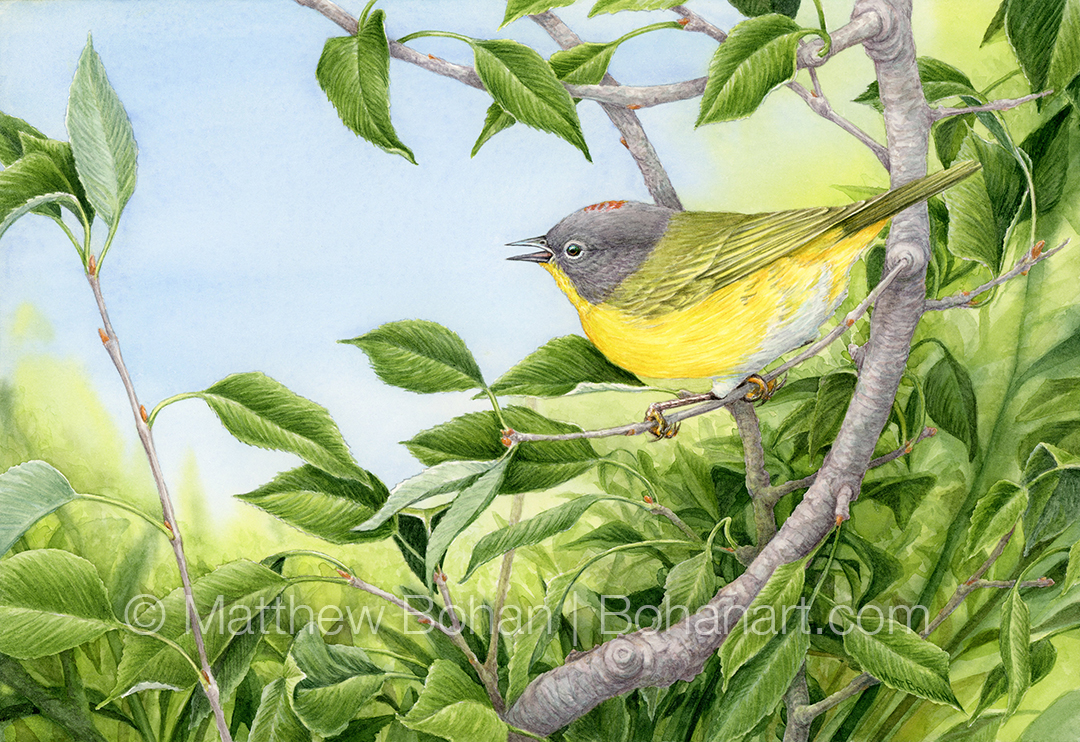

Nashville warblers are regular visitors in our yard during migration. They especially like eating insects attracted to the crabapple trees and their blossoms in the spring. They sure are cute with that little, white eye ring. These warblers have some small reddish feathers on top of their head that I’ve very seldom seen. As a diagnostic field mark on a Nashville Warbler flitting around in a tree as seen through binoculars, it is pretty much worthless! Occasionally, I’ve not even noticed the red on the cap until I get home and look through the photos on the computer.
While I’ve painted many warblers, this is my first Nashville Warbler, mostly because I’ve not gotten many great reference photos. I totally blew the exposure on the shot that I based the majority of this painting on, but the pose was fun. The background was all grays and greens from the cherry tree outside our kitchen window, but I thought it would be fun to have the bird peeking out of the foliage to an open blue sky.
Please contact me if you’re interested in buying the original watercolor or a print of this painting. Some of my work is also available for licensing.
Warbling Vireo Transparent Watercolor and Time-lapse video
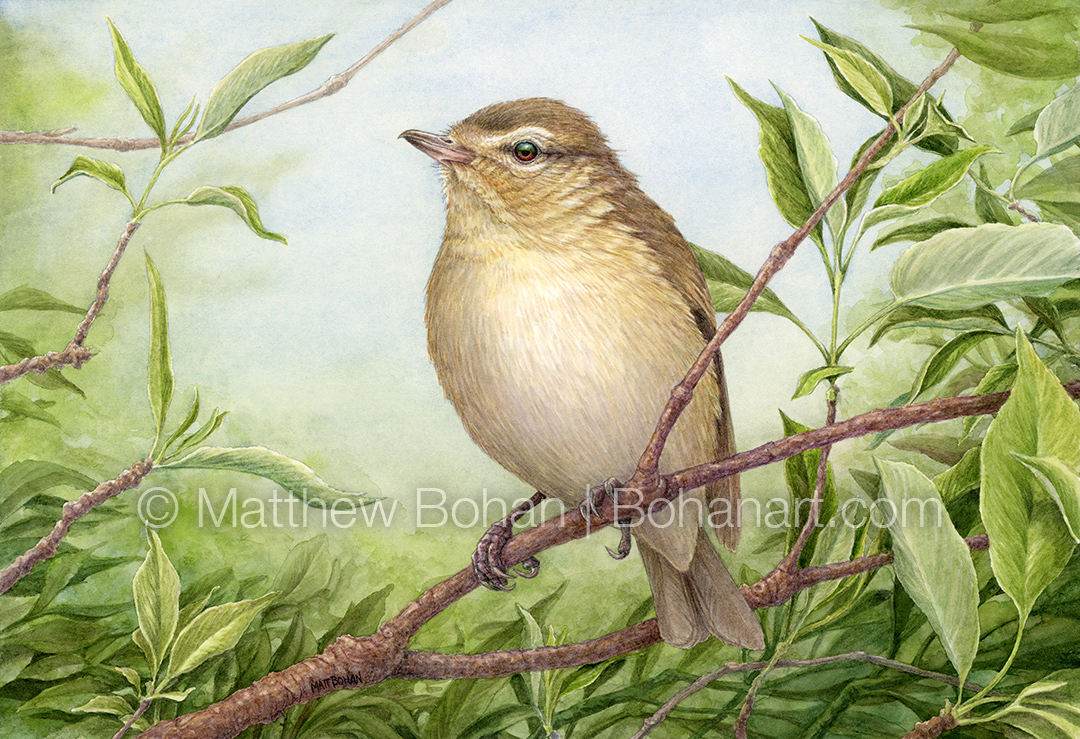
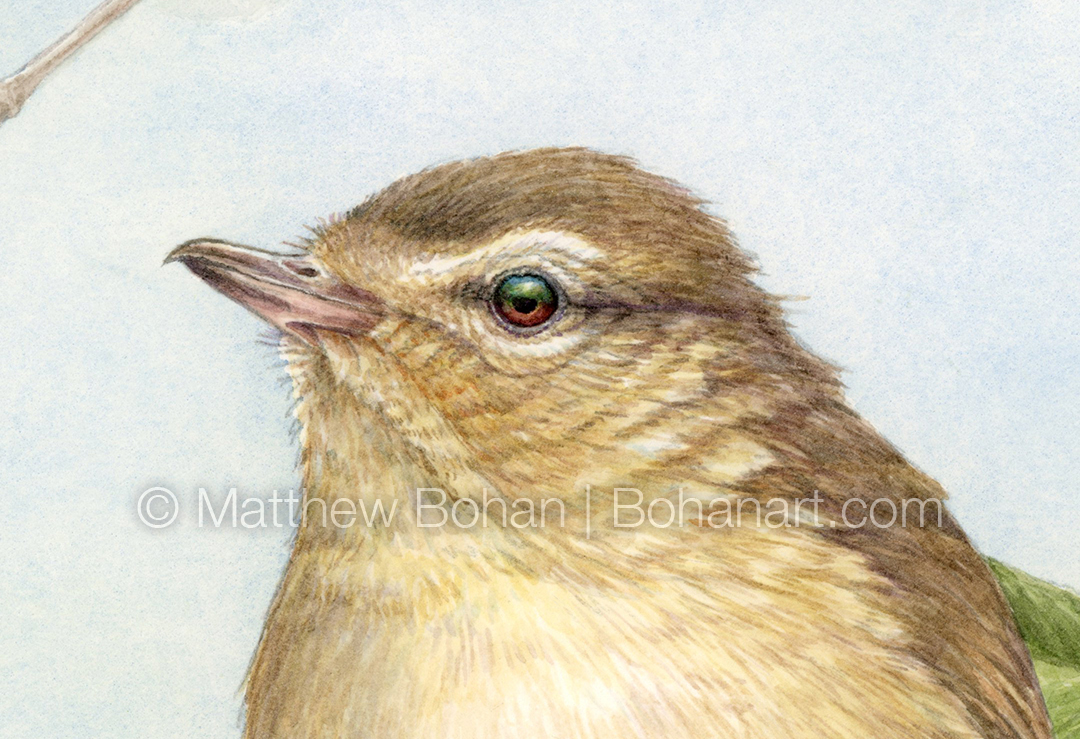
This is my first painting of a Warbling Vireo. I love all the vireo species I’ve been lucky enough to see. While the warblers seem to get all the attention with their saturated colors and patterns, the vireos have a lot of similar behaviors. While the vireos may not have the flashy colors of the warblers, they make up for it with cute stripes or rings around their eyes.
So far I’ve only painted one vireo… a Red-eyed. Honestly, part of the reason I neglected them is that they are hard to photograph. In the summertime the forested areas of central Michigan are filled with the calls of Red-eyed and Warbling Vireos. Once the trees leaf out, their cheery voices are the only evidence of these beautiful birds.
My daughter has a lot of tricks for learning bird calls. The way she remembers the Warbling Vireo is that it says, “When I see you, I will seize you, and I’ll squeeze you till you squirt!” That is a crazy saying for a long and rambling call, but it really does approximate the phrasing of its song.
Warbling Vireos have interesting nests that are hanging and cup-shaped, usually drooping down from a forked tree branch. They look cozy, woven together with grasses, lichens and other materials.
Please contact me if you’re interested in buying the original watercolor or a print of this painting. Some of my work is also available for licensing.
Marsh Wren Transparent Watercolor and Time-lapse video
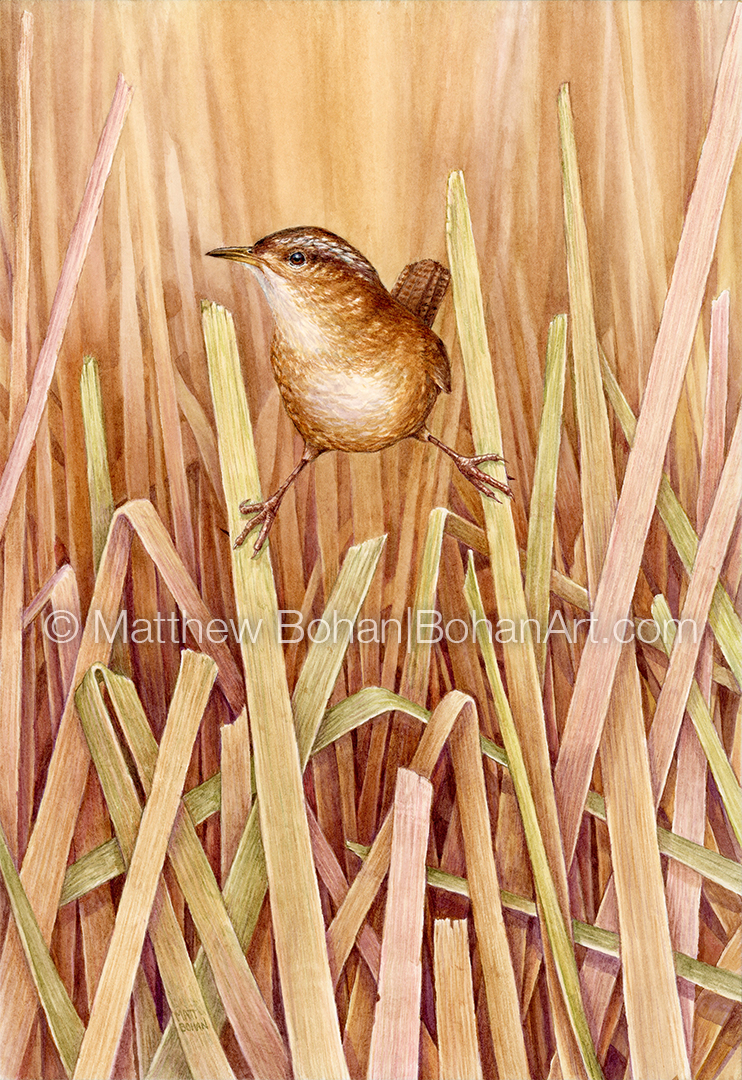
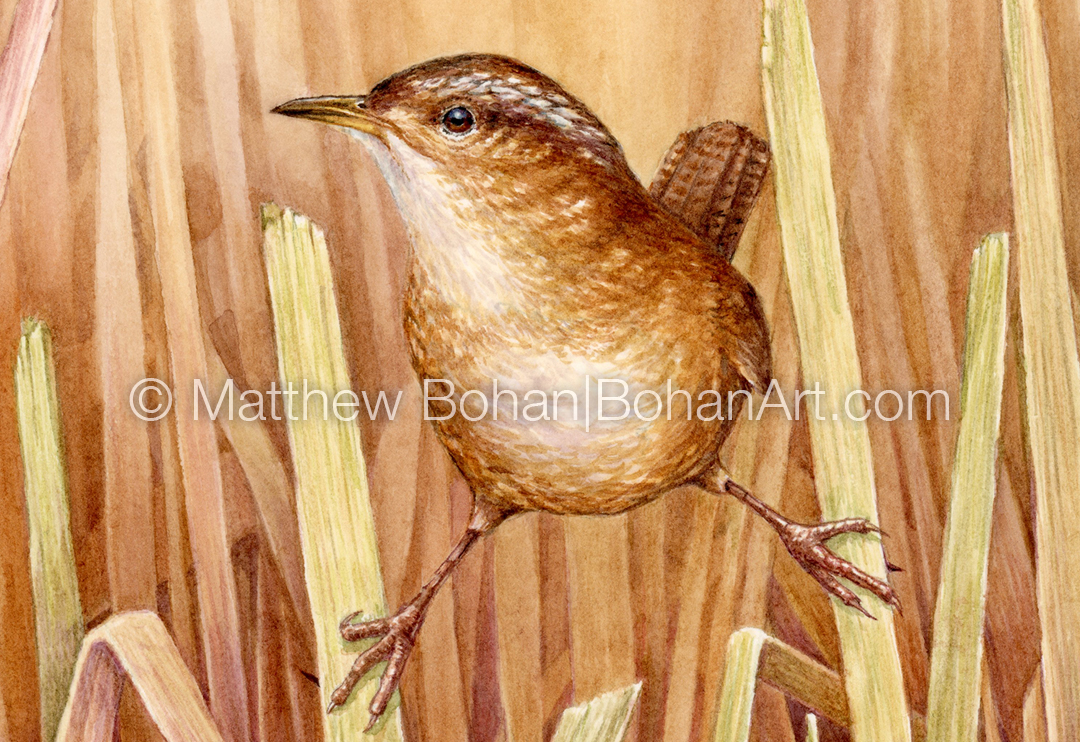
I love getting to see Marsh Wrens. They are more often heard than seen, so getting a good look is especially rewarding. I’ve occasionally seen them doing a “Van Damme” pose holding onto two cattails. Getting a photo of that was on my wish list. I finally got a chance at the Maumee Bay State Park boardwalk last spring. Wrens never sit still and are hard to photograph. They tend to pop up, sing and then drop down, disappearing into the reeds.
On top of their tiny size, speed and stealth, these individuals were nesting a bit farther away than my 400mm could pull in. A 600mm lens would’ve been ideal. After a lot of effort I got decent photos and was able to enlarge the image enough to use as a painting reference.
Painting the bird itself went really quickly, but the background took forever. In my photo the cattails were pretty uniform in color. In order to give the main “tan” colors more pop and motion in the painting, I added slight green and red shifts to select leaves. This added some needed color contrast and separation.
Please contact me if you’re interested in buying the original watercolor or a print of this painting. Some of my work is also available for licensing.
